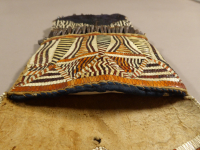two-tabbed pouch
two-tabbed pouch
two-tabbed pouch


















This two-tabbed pouch has very distinct and complex quillwork. The quillworker produced intricate positive and negative spaces. One of the tabs at the top of the pouch has two lines of quill decoration in white and orange (originally red) - though some of the quills are now missing. The middle section of the bag has what GRASAC researchers described as "psychedelic" embroidered quillwork. The lanes of quillwork are interlaced and have a sinuous quality. The designs are not geometric and controlled in the usual ways; the designs feel less controlled, but are outlined with precision. The quillworker used two to three colours in a lane, and there is ambiguity in the motifs. The bottom of the bag is decorated with a thick panel of loon feathers arranged to create two black and white triangles overtop a black pentagon. Rows of tinkle cones are attached between the quillwork and the feathers, and at the bottom of the bag. The thongs holding the tinkle cones in place were wrapped with quill, and most of the hair from the cones is now missing. The inside of the bag is lined with a blue fabric.
This relative currently resides at the Ethnologisches Museum Berlin, Germany.
Sioux, "Sisetan Sioux" Sisseton
Museum documentation and GRASAC researcher analysis
Museum documentation and GRASAC researcher notes
Read More About This Relative
hide, porcupine quill, loon feathers, tinkle cones, deer or moosehair (mostly missing), likely cotton fabric (possibly wool)
Maureen Matthews observed that the quillwork is embroidered.
Within the quillwork are triangles, Y-shapes, and curvilinear sections. It is possible that some of the motifs represent horned beings.
This bag--especially its quillwork--generated much discussion and interest during GRASAC's research visit to the Museum. Alan Corbiere described it as "psychedelic" in its design. The quillworker definitely had specific intentions. Laura Peers noted the design is "busier" than what is seen on most bags, and the quillworker used techniques differently--for example, normally curves create outlines when quillworkers are employing an embroidery technique, but this bag has curves within the design elements. Laura Peers also noted that the quillworker used multiple colours within a motif, whereas often colours are used to distinguish motifs. Both Maureen Matthews and Laura Peers thought the motifs could represent horned beings.
This relative is related in Museum documentation to a tikinagan (collected in 1839), and quillwork with hawk feathers. It has some similiarities to the two-tabbed pouch IV-B-166, however, they came from different collectors.
The item was collected in 1840, so must have been made before then. The documentation suggests origins in Missouri, and related items are identified with Sisetan Sioux. Laura Peers thought these were accurate associations based on the bag.
Provenance
Museum documentation
About This GRASAC Record
Sioux Maker, Name Unknown. Two-tabbed pouch. GRASAC ID 59169. Ethnologisches Museum Berlin, Catalogue Number IV-B-167.
This record was created by Cara Krmpotich on March 13, 2024 based on photographs and notes taken during a GRASAC research visit to the Museum in May 2019, including Cara Krmpotich, Alan Corbiere, Laura Peers, Maureen Matthews, with Hannah Turner and Charles Feaver on photography. Curator Monika Zessnik supported the visit.
Museum records associate this pouch with the Missouri River.
 Knowledge Sharing Platform
Knowledge Sharing Platform

















